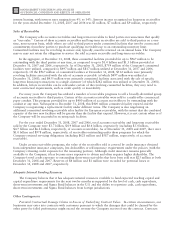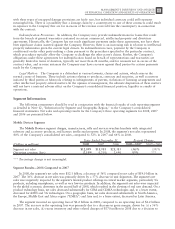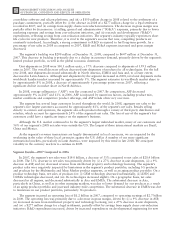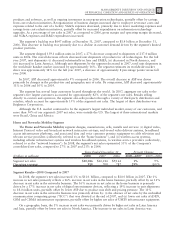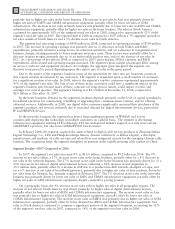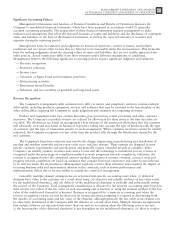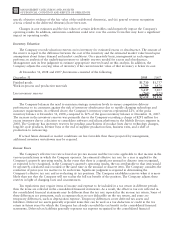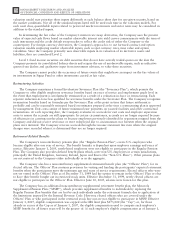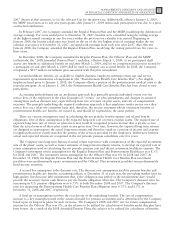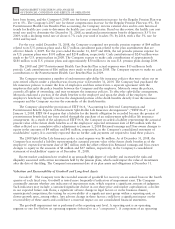Motorola 2008 Annual Report Download - page 70
Download and view the complete annual report
Please find page 70 of the 2008 Motorola annual report below. You can navigate through the pages in the report by either clicking on the pages listed below, or by using the keyword search tool below to find specific information within the annual report.
consolidate software and silicon platforms, and (iii) a $150 million charge in 2008 related to the settlement of a
purchase commitment, partially offset by: (i) the absence in 2008 of a $277 million charge for a legal settlement
recorded in 2007, and (ii) savings from supply chain cost-reduction initiatives. The decrease in gross margin was
partially offset by decreases in: (i) selling, general and administrative (“SG&A”) expenses, primarily due to lower
marketing expenses and savings from cost-reduction initiatives, and (ii) research and development (“R&D”)
expenditures, reflecting savings from cost-reduction initiatives. The segment’s industry typically experiences short
life cycles for new products. Therefore, it is vital to the segment’s success that new, compelling products are
constantly introduced. Accordingly, a strong commitment to R&D is required to fuel long-term growth. As a
percentage of net sales in 2008 as compared to 2007, R&D and SG&A expenses increased and gross margin
decreased.
The segment’s backlog was $290 million at December 31, 2008, compared to $647 million at December 31,
2007. This decrease in backlog is primarily due to a decline in customer demand, primarily driven by the segment’s
limited product portfolio, as well as the global economic downturn.
Unit shipments in 2008 were 100.1 million units, a 37% decrease compared to shipments of 159.1 million
units in 2007. The overall decrease reflects decreased unit shipments of products for all technologies. For the full
year 2008, unit shipments decreased substantially in North America, EMEA and Asia and, to a lesser extent,
decreased in Latin America. Although unit shipments by the segment decreased in 2008, total unit shipments in the
worldwide handset market increased by approximately 5%. The segment estimates its worldwide market share to
be approximately 8% in 2008, a decrease of approximately 6 percentage points versus 2007, reflecting a
significant decline in market share in North America.
In 2008, average selling price (“ASP”) was flat compared to 2007. By comparison, ASP decreased
approximately 9% in 2007 and 11% in 2006. ASP is impacted by numerous factors, including product mix,
market conditions and competitive product offerings, and ASP trends often vary over time.
The segment has several large customers located throughout the world. In 2008, aggregate net sales to the
segment’s five largest customers accounted for approximately 41% of the segment’s net sales. Besides selling
directly to carriers and operators, the segment also sells products through a variety of third-party distributors and
retailers, which account for approximately 24% of the segment’s net sales. The loss of any of the segment’s key
customers could have a significant impact on the segment’s business.
Although the U.S. market continued to be the segment’s largest individual market, many of our customers and
56% of our segment’s 2008 net sales were outside the U.S. The largest of these international markets are Brazil,
China and Mexico.
As the segment’s revenue transactions are largely denominated in local currencies, we are impacted by the
weakening in the value of these local currencies against the U.S. dollar. A number of our more significant
international markets, particularly in Latin America, were impacted by this trend in late 2008. We anticipate
volatility in the currency markets to continue in 2009.
Segment Results—2007 Compared to 2006
In 2007, the segment’s net sales were $19.0 billion, a decrease of 33% compared to net sales of $28.4 billion
in 2006. The 33% decrease in net sales was primarily driven by: (i) a 27% decrease in unit shipments, (ii) a 9%
decrease in ASP, and (iii) decreased revenue from intellectual property and technology licensing. The segment’s
product sales were negatively impacted by limitations in the segment’s product portfolio, including 3G products
and products for the Multimedia and Mass Market product segments, as well as an aging product portfolio. On a
product technology basis, net sales of products for: (i) GSM technology decreased substantially, (ii) iDEN and
CDMA technologies decreased, and (iii) 3G technologies increased slightly. On a geographic basis, net sales
decreased in all regions, and decreased substantially in Asia and EMEA. The substantial decrease in Asia,
particularly in China, as well as in other emerging markets, was due to lower demand for our products as a result
of an aging product portfolio and increased industry-wide competition. The substantial decrease in EMEA was due
to limitations in our product portfolio, particularly 3G products.
The segment incurred an operating loss of $1.2 billion in 2007, compared to operating earnings of $2.7 billion
in 2006. The operating loss was primarily due to a decrease in gross margin, driven by: (i) a 9% decrease in ASP,
(ii) decreased income from intellectual property and technology licensing, (iii) a 27% decrease in unit shipments,
and (iv) a $277 million charge for a legal settlement, partially offset by savings from supply chain cost-reduction
initiatives. R&D expenditures increased, driven by increased expenditures on developmental engineering for new
62 MANAGEMENT’S DISCUSSION AND ANALYSIS
OF FINANCIAL CONDITION AND RESULTS OF OPERATIONS










